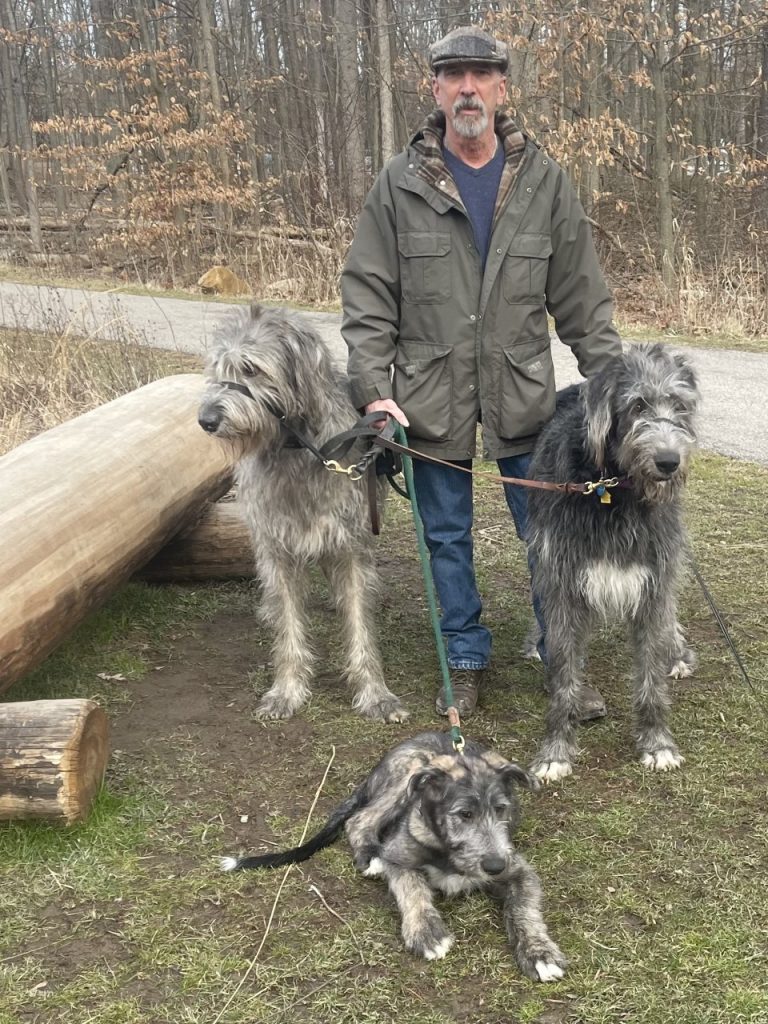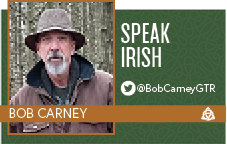

Speak Irish: The Wolf-Men of Ireland and The Irish Wolfhound
by Bob Carney
Ireland of old was inhabited by a large and fierce breed of wolf, as was much of Europe. Anyone with a little knowledge of the Irish Wolfhound will tell you that the wolfhound was bred to combat the wolf and protect the Irish people from their attacks and raids on their homes and herds.
Older stories don’t dispute that, but they state a different, somewhat darker reason for developing the breed. In a book written by early Christian monks, called the “Cóir Anmann” or the “Fitness of Names,” there is a story about a prince named Laignech and his brother Feardach, who was the first king of Osraí. The story tells us that all of the Ossorian people were shapeshifters, able to take the form of a wolf. They would go on raids, wolfing as it was refered to, attacking their enemies and their cattle, feasting on both man and beast.
Werewolf
The wolf-men of Osraí did not change like the werewolves of Hollywood, their human bodies would lie still and go cold as if dead when they would take the form of a wolf. If something happened to their human body, they would remain a wolf till their death.
In battle, a human opponent was no match for the Ossorians, and as their reputation grew. Kings would recruit them as mercenaries to fight alongside their own men, but not always with the best results. When the Ossorians were in their wolf form, they exibited the same, common wolf-like behavior; they could not be trusted. But the Irish Wolfhound was loyal.
One story received the seal of Pope Urban III and was the first recorded tale of a werewolf by the Vatican. In the year 1182, a priest was traveling down into Meath from Ulster, and stopped to rest for the night. After dark, as his fire dimmed, he heard a voice asking him to come into the forest. Frightened, he refused and asked the speaker instead to step into the light and be identified.
Suddenly, a large, old grey, but powerful wolf stepped out of the dark and spoke to him. The wolf told him that he was of the tribe of Osraí that had been cursed by St. Natalis of Kilkenney six hundred years earlier.
Two of the tribe must live as wolves for seven years, and when their time was up, another couple would take their place. He told the priest they were almost at the end of their seventh year, and that his mate had been wounded by hunters and was near her death. He requested that the priest come with him to hear her final confession, as they were both Catholics.
The priest went with the wolf to a nearby cave where the dying she-wolf lay and heard her confession just before her passing. With her final breath, she turned back into an older woman.
The priest wrote a letter to his bishop and then to Pope Urban III, and reminded them of the writings of St. Augustine should they doubt his story. “We agree then, with Augustine, that neither demons nor wicked men can either create or really change their natures; but those whom God created can, to outward appearence, by his permission become transformed, so that they appear to be what they are not; the senses of man being deceived and laid asleep by a strange allusion, so that things are not seen as they really exist, but are strangely drawn by the power of some phantom or magical incantation to rest their eyes on unreal and fictitious forms.”

*Bob Carney is a student of Irish language and history and teaches the Speak Irish class held every Tuesday at PJ McIntyre’s. He is also active in the Irish Wolfhound and Irish dogs organizations in and around Cleveland.
Wife Mary, hounds Rían, Aisling and Draoi, and terrier Doolin keep the house jumping. He can be reached at [email protected].


Monthly newsmagazine serving people of Irish descent from Cleveland to Clearwater. We cover the movers, shakers & music makers each and every month.
Since our 2006 inception, iIrish has donated more than $376,000 to local and national charities.
GET UPDATES ON THE SERIOUS & THE SHENANIGANS!